 Dollarís Purchasing Power Drops Sharply to Record Low, But Itís a Lot Worse than CPI
Dollarís Purchasing Power Drops Sharply to Record Low, But Itís a Lot Worse than CPI
Dollarís Purchasing Power Drops Sharply to Record Low, But Itís a Lot Worse than CPI Shows
by Wolf Richter ē Apr 13, 2021
If the homeownership component in CPI mirrors the Case-Shiller Home Price Index, CPI would jump 5.1%! Not to speak of new & used vehicle prices, which I nevertheless speak of.
By Wolf Richter for WOLF STREET.
The Consumer Price Index jumped 0.6% in March compared to February, the sharpest month-to-month jump since 2009, according to the Bureau of Labor Statistics today, and was up 2.6% from a year earlier, after the 1.7% rise in February.
The infamous Base Effect, which I discussed last week in anticipation of what is now coming, was responsible for part of it: CPI had dipped in March last year, which created a lower base for todayís year-over-year comparison. Over the 13 months since February last year, which eliminates the Base Effect, CPI rose 2.3%.
- Prices of durable goods continued their upward surge, rising 3.7% from a year ago (purple line);
- Prices of nondurable goods, which are largely food and energy, including gasoline, jumped 4.2% (green line);
- Prices of services rose 1.8%. This is the biggie, accounting for two-thirds of overall CPI. It is dominated by a measure for homeownership costs, which ludicrously, as home prices are exploding, merely ticked up 2.0% from a year ago. More on that in a moment.
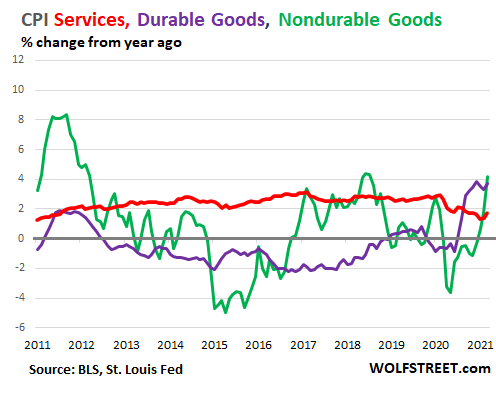
Consumer price inflation means loss of purchasing power of the consumer dollar, and thereby the loss of the purchasing power of labor denominated in dollars. And the purchasing power thus measured dropped 0.5% in March from February to a new record low, according to the BLS data. Given the insistence by the Fed on perma-inflation, the dollarís purchasing power keeps dropping from record low to record low:
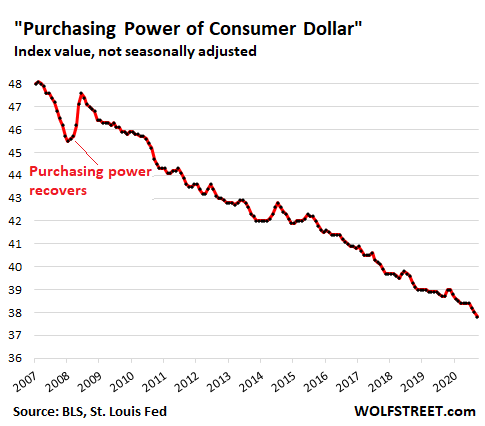
But wait, itís a lot worseÖ
The three major Consumer Price Indices Ė CPIs for durable goods, nondurable goods, and services Ė over the long term, give a fascinating picture of what is going on with the CPI itself. These indices, shown below as index value, not year-over-year percentage change, were set to a value of 100 in 1982-1984. Since then:
- Services CPI has risen steadily (red line below).
- Nondurable goods CPI rose until about 2012 and has then wobbled along in the same range, but now appears to be breaking out of that range (green line below).
- Durable goods CPI peaked in 1996 and has trended down ever since, even as actual prices of most durable goods, particularly big-ticket items such as vehicles, have surged. The recent increase in the durable goods CPI barely registers in the long-term decline (purple):
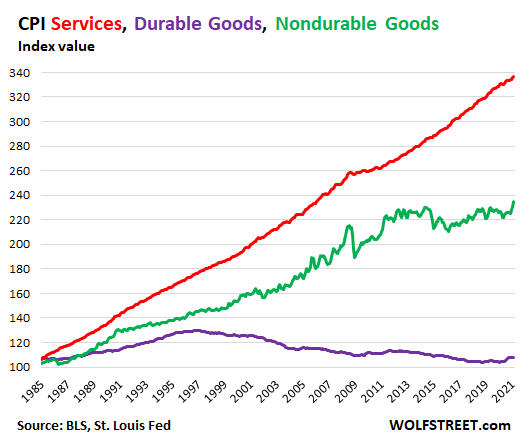
CPI for services held down by homeownership costs, which exploded in real life.
Housing costs Ė rent and homeownership costs combined Ė weigh about one-third of the overall CPI and about one-half of the services CPI. Rents of primary residence (accounting for 7.8% of overall CPI) ticked up just 1.7% in March compared to a year ago. In reality, rents have surged in many markets and plunged in the most expensive markets. So national rent increases of 1.7% might be close.
The problem in the CPI is the homeownership component, the ďOwnersí equivalent rent of residence,Ē which accounts for 24% of overall CPI. It is based on surveys of homeownersí estimates of how much their home would rent for. And this CPI for ďOwnersí equivalent rent of residenceĒ in March rose just 2.0% year-over-year (red line).
But the Case-Shiller Home Price Index, which is based on the sales-pairs method and has a better handle on housing bubble reality, soared 11.2% year-over year (purple line).
Had the homeownership component of CPI risen in line with the Case-Shiller index, the overall CPI would have jumped by 5.1% year-over-year Ė nearly double the published rate of 2.6%!
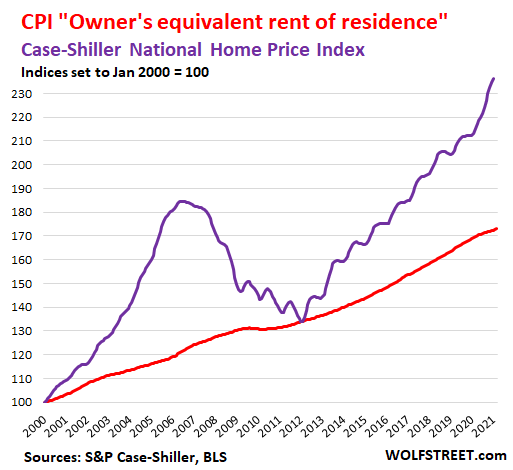
And just when you thought it couldnít get worseÖ
The long-term decline of the CPI for durable goods is of course a mirage in terms of actual prices paid for durable goods Ė everyone who has ever paid for durable goods knows that.
This is due to the increasingly aggressive use of ďhedonic quality adjustments.Ē As a product is improved and the price goes up, that price increase is then ascribed to the added costs of the quality improvements, and is therefore excluded from CPI, as CPI is supposed to track the loss of the purchasing power of the dollar, and not the costs of the improvement of products.
The theory is that youíre paying more because the product is better. This is true for consumer electronics and motor vehicles, which have vastly improved in all aspects over the past 20 years. But the aggressive application of hedonic quality adjustments leads to bizarre outcomes, including the long-term declining CPI for durable goods that has been weighing down the overall CPI.
The CPI for new vehicles Ė even as the largest dealer group in the US is bragging to Wall Street about the record prices and profit margins itís getting Ė hasnít moved at all over the past two months and was up only 1.5% from March last year, and has barely inched up the since the mid-1990s:
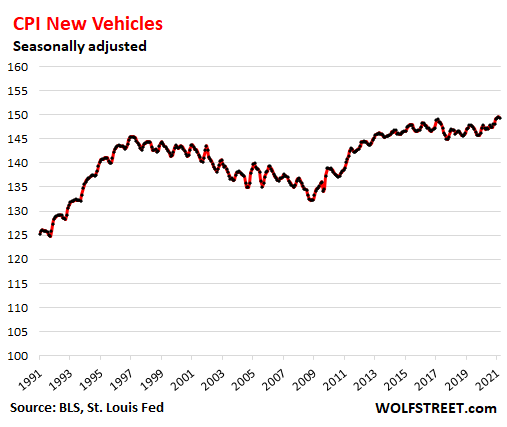
For a reality check, and for your amusement, here is my annual F-150 and Camry Price Index, representing the MSRPs of the best-selling truck and the best-selling car in the US from the 2021 model year back to the 1989 model year. The green line denotes the annual CPI for new vehicles:
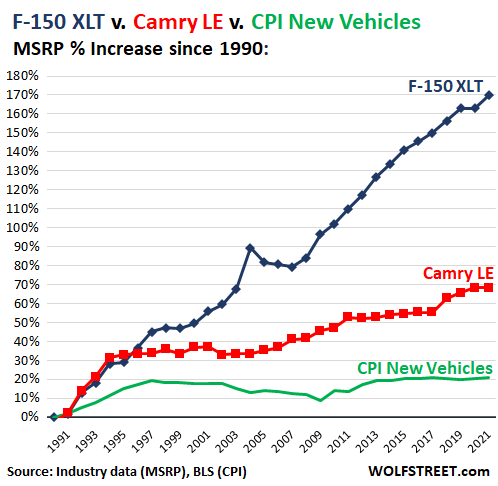
The used vehicle price shocker and hedonics.
The CPI for used vehicles is also subject to aggressive hedonic quality adjustments, but there are times when prices skyrocket so far so fast that they even outran the hedonic quality adjustments Ė and that took some doing.
The CPI for used vehicles ticked up 0.5% in March from February, after four months in a row of month-to-month declines. Those declines were likely due to hedonic quality adjustments finally catching up with prices that went haywire starting in July last year and spiked in a historic manner in the vast and liquid wholesale market as well as in the retail market.
Compared to March last year, the CPI for used vehicles was still up 9.4%, after double-digit price gains late last year. The chart shows this spike that peaked in October last year and has since backed off giving up a portion of the prior gains. But this recent decline has not been borne out by actual prices in the market, which remain red-hot.
Also note that despite the spike, the used vehicle CPI remained below the levels 20 years ago, even as actual used vehicle prices have surged. The index for March 2021 was 5.4% below the index value in March 2001. This is the power of aggressive hedonic quality adjustments:
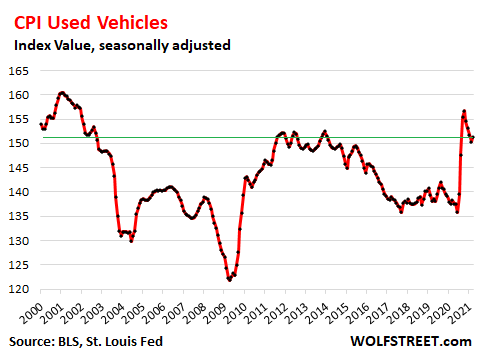
And there are more inflation pressures further up in the pipeline, as companies are reporting surging costs, and that theyíre able to pass on those surging costs to their customers. ReadÖ Producer Prices Blow Out
https://wolfstreet.com/2021/04/13/yu...han-cpi-shows/
ĒThe trouble with socialism is that you eventually run out of other people's money.Ē - Margaret Thatcher











 Reply With Quote
Reply With Quote

